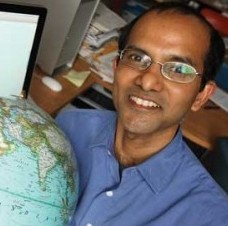
By Katherine Gombay
Remember those maps of the world in the front of your high school atlas? The ones that showed what crops were growing where? Well, it turns out they were mainly based on informed, if imprecise, speculation.
Geography professor Navin Ramankutty is now busy creating the real thing using data gathered from both satellite images and sources like the U.N.’s Food and Agriculture Organization (FAO). Ramankutty’s research lies at the intersection of agriculture and climate change. And his goal is no less than to contribute to solving the problem of global hunger by mapping current agricultural land use along with its impacts on climate change and the environment.
A big part of the problem, says the soft-spoken Ramankutty, lies in our current agricultural practices, which are only increasing our environmental problems.
The portrait he paints is a stark one.
“Right now we have one billion people in the world who are hungry. It’s estimated that in the next 50 years we’re going to have another two billion – so we need to be thinking about feeding an additional three billion people. But today’s agricultural practices involving large-scale land clearing and the overuse of fertilizers are causing a huge amount of problems – in fact, if you look at a catalogue of global environmental problems, from biodiversity loss, to freshwater depletion, to water pollution, I would argue that agriculture is the number one driver of all these changes.”
Ramankutty first began worrying about climate change when he was still very young. As a teenager growing up in Southern India, while dutifully studying engineering, he spent all his leisure time reading about the environment and climate change. While hiking through eucalyptus plantations in the mountains near his home Ramankutty and his friends discussed things like biodiversity and deforestation.
“The smell of eucalyptus still evokes memories [of that time] for me. I had a realization then, that nature was being lost and had a naïve view that maybe we can do something different to save the planet, without having a clue about what that entailed.”
Ramankutty’s first step was to come to North America to pursue graduate studies. What became increasingly clear to him over the course of those studies was that he was not simply interested in the ways that humans are changing the environment, but even more in the ways that climate change affects human beings.
Indeed, people are front and centre in Ramankutty’s current research project, which involves the laborious task of producing a global map of changing agricultural land use that goes all the way back to the 1700s. The detailed global maps he and his students have created are as precise as the county level in some places in the world.
The pattern that emerges is one of concentrations of cropland in places like India, Europe, the mid-western US, the Pampas and the Ukraine – all of the breadbaskets of the world.
“But are we feeding the people of the planet or doing other things?” asked Ramankutty bluntly. He cites the example of the Mississippi basin, whose rich, productive soils produce 40 per cent of the world’s corn. “But two-thirds of that corn goes to feed cattle, and even though we eventually eat them, we only get about 10 per cent of the calories back. So do we really need to do this? And we have huge tradeoffs for the environment.”
Should everyone then become a vegetarian?
Ramankutty’s solution to the problem of global hunger, which is based on the data he has collected, isn’t quite as radical.
“If I had to talk about one large global solution, I would talk about the de-intensification of agriculture in the high latitude regions and intensification of agriculture in tropical developing nations – which are also places where we currently have deforestation and biodiversity loss,” said Ramankutty.
Although various political factors lie in the way of such action, Ramankutty’s research suggests that it is possible to envision a real solution to global hunger. And his maps offer a concrete starting point.
To view an animated map of global agricultural land use changes, visit: www.geog.mcgill.ca/~nramankutty/animation/animation.html
